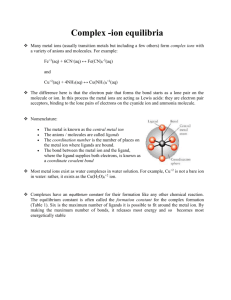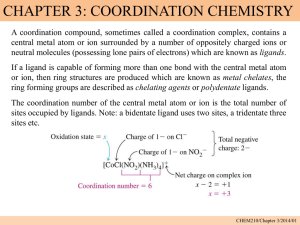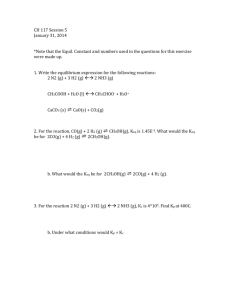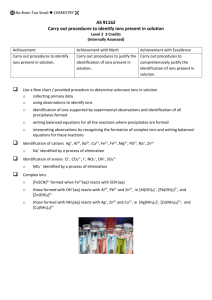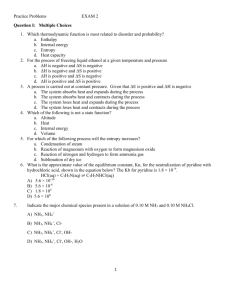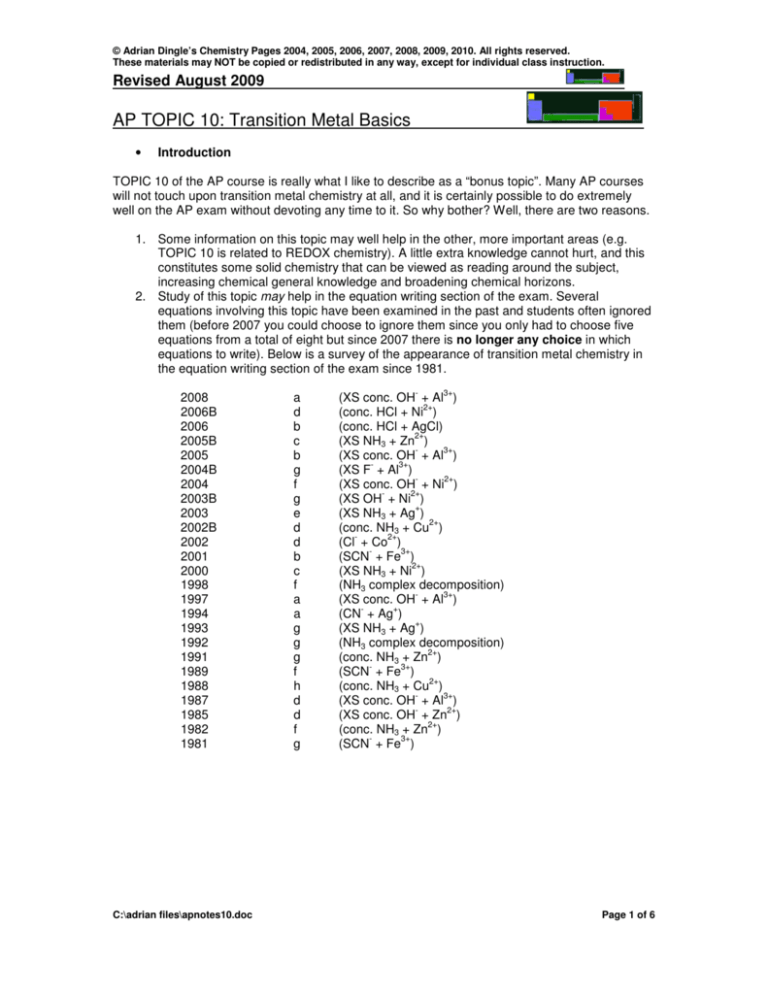
© Adrian Dingle’s Chemistry Pages 2004, 2005, 2006, 2007, 2008, 2009, 2010. All rights reserved.
These materials may NOT be copied or redistributed in any way, except for individual class instruction.
Revised August 2009
AP TOPIC 10: Transition Metal Basics
•
Introduction
TOPIC 10 of the AP course is really what I like to describe as a “bonus topic”. Many AP courses
will not touch upon transition metal chemistry at all, and it is certainly possible to do extremely
well on the AP exam without devoting any time to it. So why bother? Well, there are two reasons.
1. Some information on this topic may well help in the other, more important areas (e.g.
TOPIC 10 is related to REDOX chemistry). A little extra knowledge cannot hurt, and this
constitutes some solid chemistry that can be viewed as reading around the subject,
increasing chemical general knowledge and broadening chemical horizons.
2. Study of this topic may help in the equation writing section of the exam. Several
equations involving this topic have been examined in the past and students often ignored
them (before 2007 you could choose to ignore them since you only had to choose five
equations from a total of eight but since 2007 there is no longer any choice in which
equations to write). Below is a survey of the appearance of transition metal chemistry in
the equation writing section of the exam since 1981.
2008
2006B
2006
2005B
2005
2004B
2004
2003B
2003
2002B
2002
2001
2000
1998
1997
1994
1993
1992
1991
1989
1988
1987
1985
1982
1981
C:\adrian files\apnotes10.doc
a
d
b
c
b
g
f
g
e
d
d
b
c
f
a
a
g
g
g
f
h
d
d
f
g
-
3+
(XS conc. OH + Al )
2+
(conc. HCl + Ni )
(conc. HCl + AgCl)
2+
(XS NH3 + Zn )
3+
(XS conc. OH + Al )
3+
(XS F + Al )
2+
(XS conc. OH + Ni )
2+
(XS OH + Ni )
+
(XS NH3 + Ag )
2+
(conc. NH3 + Cu )
2+
(Cl + Co )
3+
(SCN + Fe )
2+
(XS NH3 + Ni )
(NH3 complex decomposition)
3+
(XS conc. OH + Al )
+
(CN + Ag )
+
(XS NH3 + Ag )
(NH3 complex decomposition)
2+
(conc. NH3 + Zn )
3+
(SCN + Fe )
2+
(conc. NH3 + Cu )
3+
(XS conc. OH + Al )
2+
(XS conc. OH + Zn )
2+
(conc. NH3 + Zn )
3+
(SCN + Fe )
Page 1 of 6
© Adrian Dingle’s Chemistry Pages 2004, 2005, 2006, 2007, 2008, 2009, 2010. All rights reserved.
These materials may NOT be copied or redistributed in any way, except for individual class instruction.
Revised August 2009
•
What are transition metals?
A transition metal may be defined as one that forms stable ions that have incomplete d orbitals.
(N.B. although zinc is in the d block it is often not regarded as a transition metal since in its only
10
common oxidation state (+2), it has a complete d orbital (d )). Transition metals tend to have
several different oxidation states (charges) since the s and d electrons have similar energies
meaning that there are no “big jumps” in successive ionization energies and therefore greater
numbers of electrons can be removed.
It is vitally important to remember that the outer s electrons are the first to be removed
before the d electrons when these elements form ions.
•
Two characteristic properties of transition metals
1. Transition metals form a variety of colored ions.
Some common colored ions of the third period d block elements are listed below.
+1
+2
+3
+4
Sc
colorless
Ti
violet
colorless
blue
V
violet
Green
Cr
blue
green
Mn
pale pink
Fe
pale green
yellow/brown
Co
pink
orange/yellow
Ni
green
Cu
Zn
colorless
+5
+6
yellow
yellow
(CrO42-)
brown
+7
orange
(Cr2O72-)
dark green
purple
blue
colorless
Color is caused by the movement of electrons within the d orbitals. If an ion has either a
completely filled or a completely empty d orbital then there is no scope for electron movement
and the ion will be colorless.
C:\adrian files\apnotes10.doc
Page 2 of 6
© Adrian Dingle’s Chemistry Pages 2004, 2005, 2006, 2007, 2008, 2009, 2010. All rights reserved.
These materials may NOT be copied or redistributed in any way, except for individual class instruction.
Revised August 2009
2. Transition metals form complex ions.
Since transition metal ions tend to attract electron pair donors (Lewis bases) such as water
2+
molecules. E.g. Co in aqueous solution exists attached to six water molecules.
2+
[Co(H2O)6] is an example of a complex ion and the electron pair donors (water molecules in
this case) are called ligands. The number of ligands surrounding the central metal ion is known
as the co-ordination number. The bonding between the ligands and the central metal ion is dative.
The central metal ions will attract electrons in the water molecules which leads to the O-H bonds
+
being weakened and to the release of H ions into solution. When this happens the complexes
are acidic. Higher charge density cations lead to greater attraction, greater weakening of the O-H
bonds and therefore greater acidity.
Naming complexes
(i) Neutral complexes have single word names.
(ii) As in regular nomenclature, in ionic compounds the cation is named before the anion.
(iii) Ligands are named before the central metal. Some common ligands are listed below.
Negative ligands end in ‘o’, e.g.
Ligand
Cl
OH
NO2
CN
2SO4
Name
Chloro
Hydroxo
Nitrito
Cyano
Sulfato
Neutral ligands usually keep their normal names, except the following;
Ligand
H 2O
NH3
CO
NO
Name
aquo or aqua
Ammine
Carbonyl
Nitrosyl
The number of ligands present is shown using prefixes; mono =1, di =2, tri =3, tetra = 4, penta =
5, hexa = 6
(N.B. if the ligand name begins with di/tri and there is more than one present use bis/tris/tetrakis)
C:\adrian files\apnotes10.doc
Page 3 of 6
© Adrian Dingle’s Chemistry Pages 2004, 2005, 2006, 2007, 2008, 2009, 2010. All rights reserved.
These materials may NOT be copied or redistributed in any way, except for individual class instruction.
Revised August 2009
(iv) If the complex has a negative charge the ‘ate’ is added to the name of the metal, some metals
in negative complexes may use their Latin names e.g.
Metal
Iron
Copper
Silver
Name
Ferrate
Cuprate
Argenate
(v) The oxidation state of the central metal ion is given in Roman numerals in brackets after its
name. Examples;
CATION COMPLEX:
[Fe(H2O)6] Br2
NEUTRAL COMPLEX: [Co(H2O)3(OH)3]
ANION COMPLEX:
K2 [CoCl4]
hexaquoiron (II) bromide
triaquotrihydroxocobalt (III)
potassium tetrachlorocobaltate (II)
Task 10a
1. Name the following compounds;
(i)
(ii)
(iii)
(iv)
(v)
[Cu(H2O)6]SO3
[NiCl3(NH3)3]
[Co(NH3)6]I3
Na3[Fe(CN)6]
[Cu(NH3)2(H2O)4]F
2. Write the formulae of the following compounds;
(i)
(ii)
(iii)
(iv)
(v)
ammonium hexachlorotitanate (IV)
triamminetriaquachromium (III) chloride
pentaquahydroxoiron (II)
sodium hexanitritocobaltate (III)
chloropentaamminecobalt (III) bromide
C:\adrian files\apnotes10.doc
Page 4 of 6
© Adrian Dingle’s Chemistry Pages 2004, 2005, 2006, 2007, 2008, 2009, 2010. All rights reserved.
These materials may NOT be copied or redistributed in any way, except for individual class instruction.
Revised August 2009
•
Two reactions of complex ions
3+
1. Ligand exchange reactions of transition metal ions (AND Al )
In these reactions it is acceptable to leave out the water ligands completely. E.g. when a solution
of nickel(II) ions reacts with excess or concentrated ammonia the reaction is really,
2+
[Ni(H2O)6]
2+
(aq)
+ 6NH3(aq) [Ni(NH3)6]
(aq) +
6H2O
But, simplier (and still acceptable) is,
2+
Ni
2+
+ 6NH3 [Ni(NH3)6]
The next question that may concern you is; “How do I know the number of ligands that are being
introduced in the product?” Unfortunately there are no hard and fast rules, but it’s worth learning a
few that have come up in the past.
Metal ion
Ligand
+
Cl
CN
NH3
OH
3+
F
Cl
NH3
SCN
NH3
Cl
2+
OH
NH3
OH
Ag
+
Ag
+
Ag
3+
Al
Al
2+
Co
2+
Cu
3+
Fe
2+
Ni
2+
Ni
Number of ligands
-
2
2
1 or 2
3 or 4
-
6
4
4
1
Any between 1 and 6
4
-
Ni
2+
Zn
2+
Zn
4
4
4
Two further useful pieces of information are;
(i) Often the number of ligands is twice the cation charge and,
(ii) It often doesn’t matter, as credit is often given for any number of ligands (up to a
maximum of six) as long as the overall charge is consistent with the number of ligands.
2. Decomposition of a complex by acid base neutralization
Complexes containing NH3 can be broken down via acid base decomposition by the addition of
an acid. E.g. hydrochloric acid is added to tetraamminecopper (II) sulfate
2+
[Cu(NH3)4]
+
+
2+
+ 4H 4NH4 + Cu
+
+
The NH3 acts as a base by accepting the H ions to form NH4 and the complex is broken down.
C:\adrian files\apnotes10.doc
Page 5 of 6
© Adrian Dingle’s Chemistry Pages 2004, 2005, 2006, 2007, 2008, 2009, 2010. All rights reserved.
These materials may NOT be copied or redistributed in any way, except for individual class instruction.
Revised August 2009
Task 10b
1. Add name or formula to complete the table below.
Name
Formula
Hexaquochromium (II) sulfate
[Cu(OH)2(H2O)4]
trichlorotriamminechromium (III)
2. Write the electronic configuration of these species.
(i)
(ii)
(iii)
2+
Fe
2+
Co
7+
Mn
3. What are the oxidation states of Manganese in these species?
(i)
(ii)
(iii)
(iv)
2-
[MnCl5]
3+
[Mn(H2O)6]
[MnF6]
3[Mn(CN)6]
2-
4. Yellow chromate (VI) ions (CrO4 ) can be converted to orange dichromate (VI) ions
2+
(Cr2O7 ) via a reaction with acid (H ). On addition of base (OH ) the process can be
reversed. Write a reversible equation to show the changes that are occurring in this
reaction.
C:\adrian files\apnotes10.doc
Page 6 of 6


